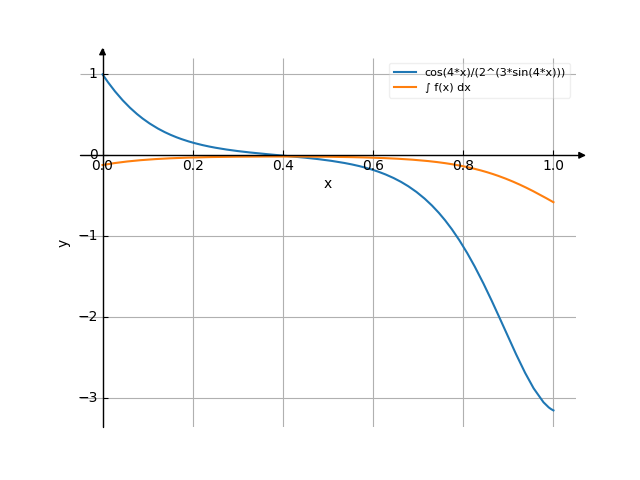Integral of cos(4x)/2^(3*sin(4x)) dx
The solution
Detail solution
-
There are multiple ways to do this integral.
Method #1
-
Let u=4x.
Then let du=4dx and substitute 4du:
∫162−3sin(u)cos(u)du
-
The integral of a constant times a function is the constant times the integral of the function:
∫42−3sin(u)cos(u)du=4∫2−3sin(u)cos(u)du
-
Let u=2−3sin(u).
Then let du=−3⋅2−3sin(u)log(2)cos(u)du and substitute −3log(2)du:
∫9log(2)21du
-
The integral of a constant times a function is the constant times the integral of the function:
∫(−3log(2)1)du=−3log(2)∫1du
-
The integral of a constant is the constant times the variable of integration:
∫1du=u
So, the result is: −3log(2)u
Now substitute u back in:
−3log(2)2−3sin(u)
So, the result is: −12log(2)2−3sin(u)
Now substitute u back in:
−12log(2)2−3sin(4x)
Method #2
-
Let u=23sin(4x)1.
Then let du=−12⋅2−3sin(4x)log(2)cos(4x)dx and substitute −12log(2)du:
∫144log(2)21du
-
The integral of a constant times a function is the constant times the integral of the function:
∫(−12log(2)1)du=−12log(2)∫1du
-
The integral of a constant is the constant times the variable of integration:
∫1du=u
So, the result is: −12log(2)u
Now substitute u back in:
−12log(2)2−3sin(4x)
Method #3
-
Let u=23sin(4x).
Then let du=12⋅23sin(4x)log(2)cos(4x)dx and substitute 12log(2)du:
∫144u2log(2)21du
-
The integral of a constant times a function is the constant times the integral of the function:
∫12u2log(2)1du=12log(2)∫u21du
-
The integral of un is n+1un+1 when n=−1:
∫u21du=−u1
So, the result is: −12ulog(2)1
Now substitute u back in:
−12log(2)2−3sin(4x)
-
Add the constant of integration:
−12log(2)2−3sin(4x)+constant
The answer is:
−12log(2)2−3sin(4x)+constant
The answer (Indefinite)
[src]
/
| -3*sin(4*x)
| cos(4*x) 2
| ----------- dx = C - ------------
| 3*sin(4*x) 12*log(2)
| 2
|
/
∫23sin(4x)cos(4x)dx=C−12log(2)2−3sin(4x)
The graph
-3*sin(4)
1 2
--------- - ----------
12*log(2) 12*log(2)
−12log(2)2−3sin(4)+12log(2)1
=
-3*sin(4)
1 2
--------- - ----------
12*log(2) 12*log(2)
−12log(2)2−3sin(4)+12log(2)1
Use the examples entering the upper and lower limits of integration.


![Find the integral of y = f(x) = cos(4x)/2^(3*sin(4x)) dx (co sinus of e of (4x) divide by 2 to the power of (3 multiply by sinus of (4x))) - with detailed solution [THERE'S THE ANSWER!] cos(4x)/2^(3*sin(4x))](/media/krcore-image-pods/176/hash/indefinite/5/84/06aa73510a2bc10612ede32fc0870.png)
 Integral of 1/(x^2+3x+2)
Integral of 1/(x^2+3x+2)
 Integral of x^2*e^(4*x)
Integral of x^2*e^(4*x)
 Integral of cos^4x
Integral of cos^4x
 Integral of sin(e^x)
Integral of sin(e^x)